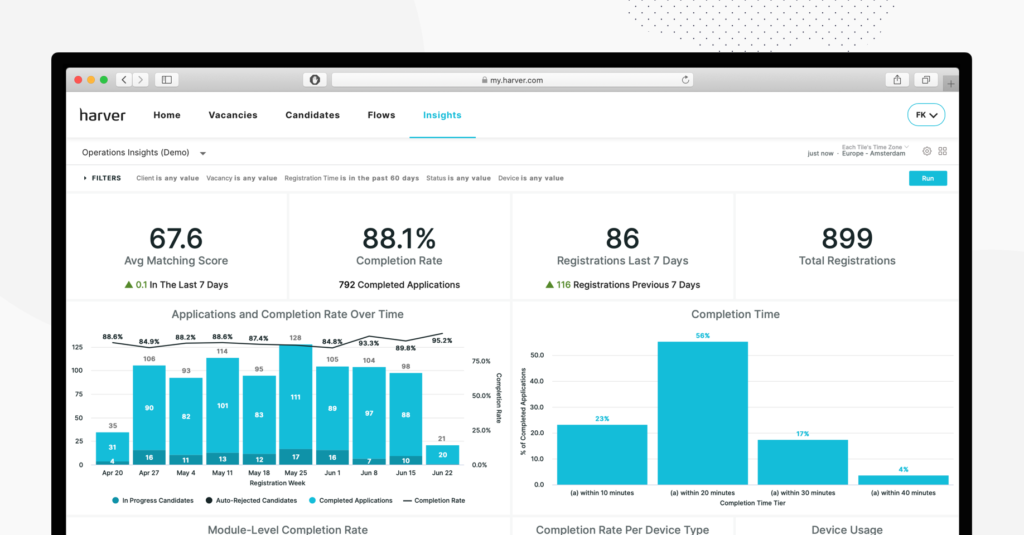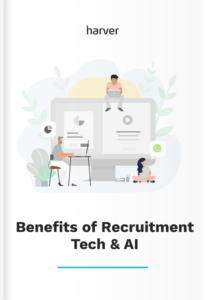Technology has disrupted the workplace. Today, we apply to jobs online, go through digital interview processes, and even work remotely. As an HR leader, it’s crucial to recognize the ways technology has become an inextricable part of today’s workforce.
A digital HR transformation is underway. In order to ensure your team and organization is properly prepared for the changes that go along with rapid technological advancements, there are a few keys to success you’ll want to follow.
Let’s explore the steps to successful digital HR transformation.
What’s in?
What is a digital HR transformation?
Digital transformation is a bit of a buzzword being thrown around at the moment. However, it’s an accurate way to describe the growing pains many organizations are experiencing thanks to the latest tech.
A digital transformation is commonly defined as the process of integrating digital technology into a business. For the HR world, this means incorporating digital technology to improve how the department (and the organization as a whole) functions.
This digital technology includes cloud-based HRIS, digital recruitment solutions, internal communication platforms, workforce engagement software, and much more.
When integrating these digital technologies, HR professionals need to consider how new apps, tools, and programs will transform the workforce and how work is performed and completed. HR teams that are able to look beyond just their own departments and operations will have a leg up on their competition.
Digital HR is more accessible, faster, transparent, and cost-efficient compared to a traditional HR system. (Image source)
How will a digital HR transformation benefit your company?
No matter how you look at it, the workforce is changing. Not only is it becoming more diverse, but employers are opting to hire more remote, part-time, or freelance workers.
A changing workforce means the way organizations manage projects, communicate, and grow culturally is also shifting. Technology is becoming more and more essential in ensuring teams are able to do their work efficiently.
The skills those employees need are also different than they were years ago. A few decades ago, having computer skills might have been a quality to list on a resume. Today, being familiar with certain apps and computer programs is expected, if not taken for granted.
Digitally transforming your HR department helps you build a workforce of the future. By staying on top of the changing needs of a dynamic team, you can improve the employee experience to create more personalized processes that encourage engagement and communication. When employees can easily and clearly converse with one another, they work more efficiently and productively.
Adding new digital elements to your workforce also allows your team to make data-driven decisions. You’re able to gather data, analyze information, and act upon it to make improvements to your strategies and workflow.
Listen to our 8 Tips For A Successful Digital HR Transformation
on Recruitment On The Go!
How to ensure a successful digital HR transformation
To ensure your digital HR transformation is as smooth as possible, here are a few key steps you need to take.
1. Define your goals
Before you implement any new technology, take a look at your current situation. Identify where your current workforce is strong and where it might be lacking. Then, consider what accomplishments you’d like your digital transformation to help you achieve.
Establishing goals before introducing any new technology can ensure you’re moving in the right direction. Having a clear aim before starting your transformation will give you a path to work towards and give you guidelines to measure your success.
Your goals may change as you go about transforming your HR––and that’s okay. If you find that a certain goal or metric no longer align with your company’s needs, change directions. However, make sure your goals are clear and specific.
64%
of HR leaders say that improving operational excellence is one of their top business objectives.
Source: Gartner
2. Gather a transformation team
Once you have your goals in place, you need to determine who is in charge of making sure those goals are achieved. Your transformation team should be responsible for the digital HR transformation process.
Your digital transformation team should be comprised of multiple experts. First, you need someone on your team that understands the HR processes and how they contribute to the organization’s productivity as a whole.
Second, you’ll need experts in digital transformation who know how technology can refine and enhance those processes. Lastly, a change manager should facilitate the shift and ensure everything is properly in place.
Getting the right team in place can help your transformation take root as efficiently as possible and prevent any unnecessary roadblocks from popping up along the way.
3. Develop a strategy
A strategy is key to efficiently transforming your organization. Without a clear process in place, your transformation team will not know what steps to take next or what kinds of technology they need to implement.
Using the goals you’ve established, breakdown a step-by-step plan that outlines how you’re going to get from where you are to where you want to be.
Identify what steps you’re going to take first, and what you’re going to do when those steps are completed. Think both short-term and long-term to create a complete recruitment strategy that brings you through your transformation process.
Just as your goals might change, your strategy might too. You shouldn’t cling to your initial plan at all costs. If you need to change your steps, add new processes, or even eliminate a part of your plan, do so. Stay focused on moving towards your goals, even if it means shifting gears.
Like what you see?
Don’t miss out. Subscribe to our quarterly digest to get the latest TA and TM resources delivered right to your inbox.
4. Build the right tech stack
Your tech stack should give you the support you need to complete your strategy. Based on the goals you want to accomplish and the steps you need to follow, identify what kind of tools or apps you need to make that possible.
Consider how different hiring tools will work together. While you can manually connect apps and tools, selecting a tech stack that automatically integrates can make your life easier. When selecting your tech stack, choose options that have pre-established connections or integrations so you can get up and running faster.
You also want to consider who will be using this technology. Choose apps that have a strong user experience and a layout that is easy for new users to pick up. You don’t want to create a tech stack that is too complicated for your employees to use efficiently.
How AI & recruitment technology is changing recruiting experience
Find out how tech has helped other companies grow by enhancing both the recruiters’ and candidates’ experience!
5. Don’t be afraid to experiment
There is no cookie-cutter approach to digital transformation. Although digital HR transformation seems to be a hot topic these days, you won’t find a “complete guide” to bring you through the process. This is because each company and team will have their own unique needs, challenges, and goals.
Don’t be afraid to try something new. Experiment with the technology you’re using or the processes you’ve created. Look for more efficient ways you can achieve your goals and try new paths to getting them done. Evaluate how well each system works and eliminate the processes that don’t bring you closer to achieving your goals.
However, be smart about your experiments. Make small changes so you can identify what exactly works and what doesn’t. Give each new process time to sink in before introducing anything new so you can get a clear picture of how well your experiments are working.
6. Measure results
Keeping an eye on your results can tell you how close (or far) you are from accomplishing the goals you’ve established. Measuring your outcomes from each experiment lets you know where you are on your path to a complete digital transformation.
In order to effectively measure results, you need to know what you’d like to achieve. Each experiment you introduce should clearly connect to one of your larger goals and to a measurable recruitment metric. However, you want to be as specific as possible when measuring your results.
For example, a digital HR transformation experiment you introduce may improve employee engagement. To truly measure your results, you need to measure employee engagement before and after. You can then compare results to see how your experiment moved the needle towards achieving your overall goals.
Note: Measuring recruitment KPIs requires not only clarity on what you want to track, but also the proper tools for it. The Harver platform enables you to easily measure the right hiring metrics and to extract actionable insights through a series of easy to use recruitment dashboards.

7. Be transparent
Digitally transforming your HR department will not only influence the way those employees work but will also create changes for your entire company. Transparency around what is happening within the organization can help employees deal with the growing pains.
Employees will need to be well educated on how rules are changing, what new processes they may need to know, and what new technology will be introduced.
Keeping them well informed can also help them understand how they can help the company as a whole achieve your overall goals. Letting them give ideas or feedback can allow them to get involved in the transformation and ensure you’re working as efficiently as possible.
Make the appropriate information available to each employee, as well as the candidates you’re interviewing or hiring. Let them know what data you’re tracking and why you’re keeping an eye on that information. Make sure they’re properly updated in the event of any changes or new introductions.
8. Don’t lose sight of your company culture
When digitally transforming your HR department, it’s easy to make your new technology the focal point of your organization. It’s exciting to automate and datafy your HR processes. However, it’s important to remember that your employees should still be the center of your company.
Your new technology and digital processes should enhance your company culture––not replace it. When creating and implementing your digital HR transformation plan, keep your employees in mind. If a step seems like it would make your team’s work more challenging, it’s time to re-evaluate.
Throughout your digital transformation, keep an open dialogue with your employees. Get their feedback on the new systems and processes and take their opinions into account. Refine your plan according to what is and isn’t working for them.
80%
of organizations that fostered a digital culture reported breakthrough performance as a result of the digital transformation.
Source: BCG
Conclusion
Digital transformation isn’t something that will happen overnight. To get strong results that can bring your company into the new technological world, you need to establish clear goals, create a solid plan, and efficiently track results.
Let’s recap the eight steps to a successful digital HR transformation:
- Define clear goals for what you’d like to accomplish through digital transformation.
- Establish a transformation team to lead your process.
- Create a strategy that brings you closer to achieving your goals.
- Build the right tech stack to support your digital transformation.
- Don’t be afraid to experiment, but do so strategically.
- Effectively measure results to see how close you are to achieving your goals.
- Be transparent with employees about how rules or expectations are changing.
- Prioritize employees and stay focused on maintaining company culture.
Expect the digital transformation process to take some time. Because technology is still growing and developing, your plans and processes will likely need to change as new tools or apps come about.
However, when you prepare to stay agile and consistently revisit your goals, tech stack, and employees’ needs, you can digitally transform your HR department to be more efficient and productive.
How AI & recruitment technology is changing recruiting experience
Find out how tech has helped other companies grow by enhancing both the recruiters’ and candidates’ experience!


